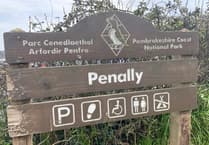A scheme to extract waste from a disused quarry which may have once provided slates for the Houses of Parliament is expected to get the go-ahead.
Alan James Ai Feibion CYF seeks permission to remove slate waste from Gilfach Quarry, Llangolman on the Pembrokeshire/Carmarthenshire border; the waste being used as a secondary aggregate in a variety of projects – such as agricultural farm tracks, as sub-bases for agricultural buildings and other engineering works.
The application is recommended for conditional approval at the January 9 meeting of Pembrokeshire County Council’s planning committee.
It is not known when quarrying at historic slate quarry Gilfach, close to the Carmarthenshire border, started, but it was noted as ‘disused’ as far back as a 1956 application, and was later registered as a ‘dormant’ site in the first list of minerals sites in 1996.
The greenish-grey/blue slate quarried in the area is said to be of Ordovician volcanic ash origin, with online sources such as Wikipedia claiming slate from Gilfach was used on the roof of the Houses of Parliament when rebuilt in the 1830s.
The proposed extraction site, an old slate tip, itself forms a small part of the overall site; it is anticipated that the site would yield some 79,030 m³ of materials, which would equate to approximately 110,642 tonnes, with a maximum tonnage of 10,000 expected to be extracted a year.
A report for planners says: “The applicant has indicated that there is a local demand for this sort of material in the area.
“The applicant owns a civil engineering business and carries out various works on agricultural holdings where this material could be utilised in the use of tracks and/or subbase for buildings.
“The applicant also intends to supply stone to local stone masons, in additional to local farmers who have contacted the applicant since they have bought the site.”
In a planning complication, the access for the site is within the Pembrokeshire, but the public highways are under Carmarthenshire jurisdiction.
Neither authority has raised objections on highways grounds but requests for surfacing access warning signage were made.
The report for planners concludes: “In conclusion, the proposed development would be in accord with the aims and objectives of local and national planning policy and would contribute towards sustainable minerals planning in the county and would not result in any significant impacts, justifying the refusal of the application.”
The application is recommended for approval subject to a long string on conditions.




